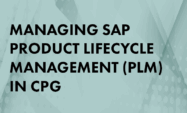SAP Manufacturing
Filter By
Browse By
- SAP Analytics and AI
- SAP Application Development and Integration
- All SAP Application Development and Integration
- SAP ABAP
- SAP ABAP Development Tools
- SAP ABAP Test Cockpit
- SAP API Management
- SAP BAPI
- SAP Basis
- SAP BRF
- SAP Business Application Studio
- SAP CMS
- SAP Design Studio
- SAP Development Tools
- SAP DevOps
- SAP EAI
- SAP EDI
- SAP Extension Suite
- SAP Fiori
- SAP Fiori Elements
- SAP Integration Suite
- SAP Low Code Application Development
- SAP Low Code Automation
- SAP Netweaver
- SAP Release Management
- SAP UI5
- SAP Web Application Server
- SAP Web IDE
- SAP Business Process Management
- SAP Center of Excellence
- SAP CIO
- SAP Customer Experience
- SAP Data and Data Management
- All SAP Data and Data Management
- SAP BW
- SAP BW/4HANA
- SAP Crystal Reports
- SAP Data Archiving
- SAP Data Center
- SAP Data Governance
- SAP Data Integration
- SAP Data Migration
- SAP Data Quality
- SAP Data Services
- SAP Data Strategy
- SAP Data Visualization
- SAP Data Warehouse Cloud
- SAP DMS
- SAP Document Control
- SAP EIM
- SAP ETL
- SAP ETL Tools
- SAP HANA
- SAP HANA Administration
- SAP HANA Deployment Infrastructure
- SAP HANA Studio
- SAP Master Data
- SAP Master Data Governance
- SAP MDM
- SAP Enterprise Architect
- SAP Enterprise Asset Management
- SAP ERP
- SAP Finance
- All SAP Finance
- SAP Accounting
- SAP AR AP
- SAP Asset Accounting
- SAP Billing Systems
- SAP BPC
- SAP BRIM
- SAP Cash Management
- SAP Central Finance
- SAP Controlling
- SAP COPA
- SAP Cost Center Accounting
- SAP Currency Risk
- SAP e-invoicing
- SAP FICO
- SAP Finance Automation
- SAP Advanced Financial Closing
- SAP Financial Consolidation
- SAP Financial Planning
- SAP FX Risk
- SAP General Ledger
- SAP Global Tax Management
- SAP Hyperion
- SAP Order to Cash
- SAP Payment Processing
- SAP Profitability Analysis
- SAP Rebate Management
- SAP S/4HANA Finance
- SAP SWIFT Compliance
- SAP Treasury Management
- SAP Universal Journal
- SAP Governance Risk and Compliance
- SAP Human Capital Management
- SAP Intelligent Technologies
- SAP Platform and Technology
- All SAP Platform and Technology
- SAP Business Technology Platform
- SAP Cloud
- SAP Cloud Connector
- SAP Cloud Integration Platform
- SAP Cloud Migration
- SAP Cloud Platform
- SAP Cloud Providers
- SAP Cloud Strategy
- SAP Digital Signature
- SAP Container Platform
- SAP HANA Enterprise Cloud
- SAP Digital Asset Management
- SAP Smart Forms
- SAP HEC
- SAP Digital Integration Hub
- SAP Hyperscalers
- SAP Infrastructure
- SAP Messaging
- SAP Quality and Testing
- SAP Security
- SAP Spend Management
- SAP Supply Chain Management
- All SAP Supply Chain Management
- SAP APO
- SAP Asset Management
- SAP Business Network
- SAP Digital Manufacturing Cloud
- SAP Digital Twin
- SAP EWM
- SAP IBP
- SAP Inventory Management
- SAP Label Printing
- SAP Logistics
- SAP Manufacturing
- SAP Manufacturing Automation
- SAP MES
- SAP MII
- SAP MM
- SAP MRO
- SAP MRP
- SAP Order Management
- SAP Plant Maintenance
- SAP PLM
- SAP Production Planning
- SAP S&OP
- SAP SD
- SAP SPM
- SAP Supply Chain Planning
- SAP Track and Trace
- SAP Transportation Management
- SAP System Administration
Manufacturing Defined
Manufacturing refers to the creation of finished goods with the help of equipment, labor, machines, tools, parts, and raw materials. It includes variable factors like supplies, equipment, overhead, parts, and skilled workers. Production planning and scheduling contain comprehensive planning features and integrated scheduling to create efficiencies and lower costs. Modern manufacturing solutions include on-premise deployment, collaboration enterprise-wide, seamless digital capabilities, and real-time analytics for problem-solving and robust decision-making.
SAP Manufacturing
Key Capabilities of SAP S/4HANA Manufacturing for planning and scheduling include:
- Comprehensive end-to-end planning: Planning production resources beyond material requirements planning (MRP) functionality, considering capacity and material availability constraints in the planning model, and integrating manufacturing master data.
- Integrated scheduling: Streamline scheduling through global production environments, use industry scheduling for block, campaign, shelf-life and model mix planning, and perform detailed scheduling.
Manufacturing Defined
Manufacturing refers to the creation of finished goods with the help of equipment, labor, machines, tools, parts, and raw materials. It includes variable factors like supplies, equipment, overhead, parts, and skilled workers. Production planning and scheduling contain comprehensive planning features and integrated scheduling to create efficiencies and lower costs. Modern manufacturing solutions include on-premise deployment, collaboration enterprise-wide, seamless digital capabilities, and real-time analytics for problem-solving and robust decision-making.
SAP Manufacturing
Key Capabilities of SAP S/4HANA Manufacturing for planning and scheduling include:
- Comprehensive end-to-end planning: Planning production resources beyond material requirements planning (MRP) functionality, considering capacity and material availability constraints in the planning model, and integrating manufacturing master data.
- Integrated scheduling: Streamline scheduling through global production environments, use industry scheduling for block, campaign, shelf-life and model mix planning, and perform detailed scheduling.
Key Capabilities of SAP S/4HANA Manufacturing for production engineering and operations include:
- Streamlined engineering: Digital collaboration with master data, design handovers, process planning, and change management. Simplify build package creation, management, and delivery for global environments.
- Enhanced operations management: Analyze change impact and change implementation. System-optimized monitoring of shop floor operations with issue detection, root cause analysis, and decision support.
The importance of manufacturing is that it leads to research and development, innovation, productivity, exports, and jobs. It helps to raise living standards and generates more economic activity than any other business sector.
3 benefits are:
- Simplify functionality: Digital enterprise collaboration to simplify product planning, change management, and operations. Decrease days in inventory by integrating scheduling and execution for a full view of product data.
- Optimize adaptability: Minimize production disruptions in shop floor execution. Reduce cycle time by adapting production schedules to plant conditions.
- Enhance planning capabilities: Streamline build package creation, planning, and shop floor operations. Reduce revenue loss from stock outs by improving flexibility into production planning scenarios.
Vendor partners to modernize your manufacturing and increase efficiency include: Forcam, SAP, and Movilitas.
Key Considerations for SAPinsiders are:
- Expert Panel Discussion: Boost Manufacturing Agility and Flexibility with SAP HANA. Listen to leaders engage about the state of manufacturing agility and flexibility by using SAP HANA.
- Belmo Increases Warehouse Productivity and Order Fulfillment by 30%. Read the case study on how the use of technology, like machine learning, can have significant benefits.
- Industry 4.0: The Journey to the Future of Productivity. Read about the importance of digital technologies, but also understand automation and collaboration are the path to success.
498 results
-

- SAP S/4HANA Finance
 Premium
Premium
Legal Entity Design Considerations in Global SAP Implementations
Reading time: 7 mins
Tanya Duncan’s experiences with global SAP finance implementations in Europe, Mexico, and Singapore have all had one commonality: complex legal entity structures. Designing company codes and plants in an SAP system is not always straightforward and this article presents several considerations in building these structures effectively. Key Concept Maquiladora is a factory in Mexico run...…
-

How Replicating SAP Data Benefits Manufacturing Organizations
Reading time: 4 mins
In today’s data-driven world, organizations are generating more data than ever before — from internet of things monitoring of machines and systems to order and fulfillment tracking. Turning your manufacturing data into meaningful insights requires the ability to access and analyze it quickly and easily.
-

- SAP MII
 Premium
Premium
Sappi Limited Gains Real-Time Visibility into Production Costs with SAP MII
Reading time: 8 mins
Sappi Limited has grown to become a leading global producer and supplier of dissolving wood pulp, paper pulp, and paper products — with an expanded system landscape to match. Its Southern Africa division recognized an opportunity to improve efficiency by consolidating the data spread across its multiple manufacturing systems. Learn how Sappi Southern Africa used…
-
-

What Long-term Benefits SAP Users Can Expect from B2B Collaborations
Reading time: 2 mins
Those businesses seeking modernization of their operations should watch out for collaborations between leading technology suppliers.
-

Life Sciences Product Lifecycle Management (PLM) with SAP
Reading time: 4 mins
The article highlights the critical role of SAP Product Lifecycle Management (PLM) in the life sciences industry, emphasizing its ability to streamline complex processes from R&D to post-market surveillance while ensuring compliance with regulatory requirements.
-

Managing SAP Product Lifecycle Management (PLM) in CPG
Reading time: 4 mins
SAP Product Lifecycle Management (PLM) serves as a crucial integrated platform for consumer packaged goods (CPG) companies, helping them manage product development efficiently while balancing the demands of speed, cost, quality, and compliance in a rapidly changing market.
-

 Premium
Premium
Use a Custom ABAP Report to Find “Labor Hours Confirmed on Production Orders” Data Entry Mistakes… Before Your Month-End Closing
Reading time: 9 mins
At some R/3 sites, the labor time spent on any given Manufacturing Order is recorded at a standard value, possibly as part of a backflushing transaction; at others, the hope is to have the operators record their actual time spent on each given Manufacturing Order, leaving wide open the possibility that operators may introduce data...…
-
-

- SAP Asset Management
 Premium
Premium
SAP Asset Performance Management for Circular Manufacturing
Reading time: 4 mins
The manufacturing industry is a major contributor to carbon emissions, accounting for around 20 percent of global emissions. These emissions are primarily caused by energy usage during the manufacturing process. However, new approaches to designing, producing, and disposing of goods can reduce waste by eliminating it from products and processes, as well as by recycling…
-

- SAP Internet of Things
 Premium
Premium
Digital Twin Enabled Manufacturing Planning
Reading time: 3 mins
This article discusses how SAP customers have numerous options for building digital twin-enabled manufacturing planning capabilities. Membership Required You must be a member to access this content.View Membership LevelsAlready a member? Log in here
-

 Premium
Premium
Complete the Engineer-to-Order Process with Period-End Postings for Project Valuation
Reading time: 16 mins
In an engineer-to-order manufacturing environment, you iteratively design a product with your customer and then produce the product based on these newly developed specifications. These projects typically run over many financial periods. At the end of each period, you need to ensure that you correctly value the work in process, the cost of goods sold,...…
Become a Member
Unlimited access to thousands of resources for SAP-specific expertise that can only be found here.
Become a Partner
Access exclusive SAP insights, expert marketing strategies, and high-value services including research reports, webinars, and buyers' guides, all designed to boost your campaign ROI by up to 50% within the SAP ecosystem.
Upcoming Events
Related Vendors
Your request has been successfully sent


